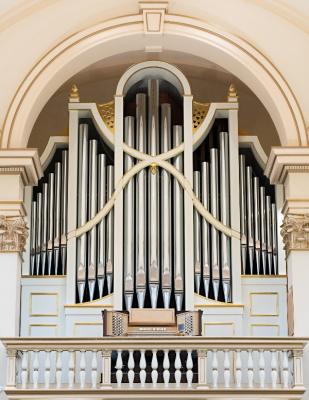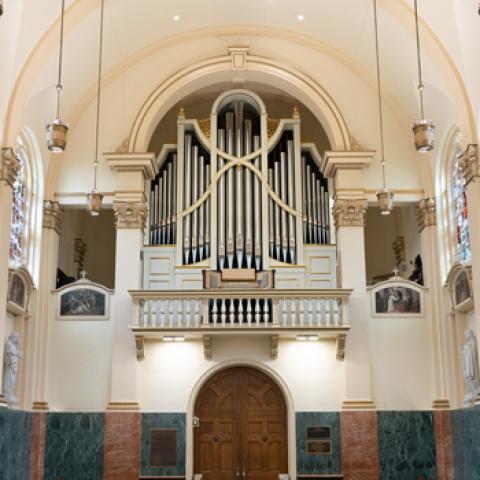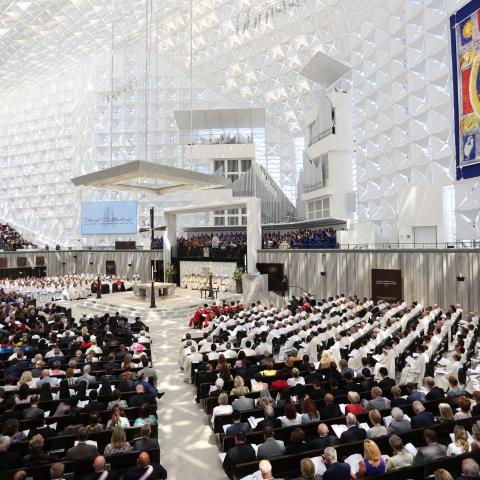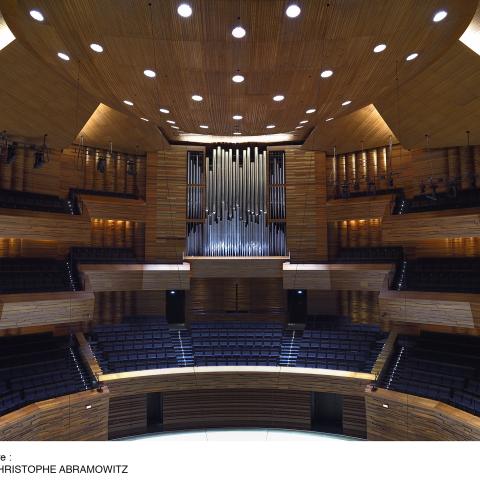Fratelli Ruffatti, Padova, Italy; Notre Dame Seminary, New Orleans, Louisiana

Flexibility is the key
The new instrument for Notre Dame Seminary of New Orleans is a two-manual organ. In spite of its relatively moderate size, however, it is designed to be more flexible in its use than many of its three-manual counterparts. This is made possible primarily by the careful choice of stops and console controls by sacred music director Max Tenney in collaboration with the builder.
A notable and not-so-common feature is the division of the Grand-Orgue into two sections, unenclosed and enclosed. The first contains the principal chorus, based on a 16′ Principal, while the latter includes flutes, a Gemshorn with its Celeste, and a rather powerful reed. Versatility not only comes from graduating the volume of the enclosed stops, but goes well beyond. Let’s look at how this is accomplished.
Each section of the Grand-Orgue is equipped with its own set of sub and super couplers and a Unison Off. The unusual possibility of applying interdivisional couplers and Unison Off only to a few stops and of using them in conjunction with other non-coupled stops within the same manual offers new and exciting possibilities. As an example, the Great Trompette, which is only controlled by one stop knob at 8′ pitch, can be used at 16′, 8′, and 4′ (and under expression) with a non-coupled principal chorus.
The console controls include a Grand-Orgue Enclosed to Expressif Transfer, which can separate the two Grand-Orgue sections in a single motion, canceling the stops drawn on the first manual and transferring them to the second. The two Grand-Orgue sections, now located on separate keyboards, can be used in dialogue, one against the other. In addition, the transfer makes it possible to use the enclosed Grand-Orgue stops with the stops of the second manual, which are also under expression. Imagine the possibilities!
A further step toward the separation of the two Grand-Orgue sections is their separate set of couplers (at 8′ and 4′) to the Pedal. There are more controls to stimulate creativity, such as the Manual Melody coupler, the Grand-Orgue Trompette coupler, and the Pedal Divide.
The most important contribution to tonal flexibility, however, is the result of very careful choices of dimensions and manufacturing parameters of the pipes, which comes from decades of experience. Together with refined voicing techniques, a good blending of each stop in all traditional stop combinations is guaranteed. In addition, the performer can create registrations that are often considered unconventional but provide valid musical solutions to whatever challenges arise. With proper voicing and pipe dimensioning, a smaller instrument can display a tonal flexibility comparable to that of a much larger pipe organ.
Technically, the console has much to offer. In addition to quality tracker-touch keyboards (61 keys), a 32-note standard AGO pedalboard, and an ergonomic design, it is equipped with a very reliable and well-tested control panel, which is remarkable in many ways. It displays a user-friendly touchscreen—by a simple touch the organist can jump from one icon to the next to access different functions. The icons are many, but all are intuitive to put any organist at ease from the first experience.
The combination action, which includes both generals and divisionals, offers great flexibility. As is often the case with modern systems, organists can have their own dedicated “folders.” Password input is not needed to open them; a personalized magnetic “key” placed next to a sensor will allow access. The storing of combinations is made simple by giving them the name of the piece for which they were set (i.e., Widor Toccata). Further, a number of such pieces can be selected and grouped into concert folders, which can be given a name as well (i.e., Christmas Concert 2021).
—Francesco Ruffatti
Partner & Tonal Director
The organ case
Designing a new pipe organ is always an exciting process. Many things must be taken into account, both from the technical and the visual standpoints. Technically, it is always a challenge to make sure that every part is easily accessible, that every pipe is reachable for tuning, that the various divisions speak freely into the building, and that all technical elements fall into place properly. Visually, the design is the result of a combination of several aspects: the environment in which the organ is located, the client’s wishes, and the designer’s creativity.
The chapel at Notre Dame Seminary is not a large building, yet it is a place with high, vaulted ceilings and classical architectural design. The organ and the console find their place in the loft above the main door, where the choir will sing under the direction of music director and organist Max Tenney.
The casework was stipulated to be of classical design, with the largest pipes in the façade. Our approach to the design follows this criteria, but with a contemporary touch to it, in an effort to blend the classical style with features that belong to the 21st century. The case is divided into five bays, with the central bay capped by an arch, thus recalling the big central arch dividing the loft from the chapel. The side bays closest to the center have counter arches, which bring more emphasis to the central bay, while the bays to their sides are a natural conclusion to the organ case containing the smaller façade pipes.
The organ façade features a decorative element in front of the pipes, which enriches the design as a whole. This element develops from the top of the arched roofs next to the central bay and follows its curve, spanning through the three central bays. The decoration crosses in front of the central pipe and changes its curvature until it reaches the vertical columns, where it is replaced by gilded shadow gaps, and then continues on the low part of the side bays, matching the curvature of the pipe mouths of the outermost bays.
The case is finished with a white lacquer and is enriched by 24-carat gold leaf accents, to complement the interior scheme of the planned redecoration of the chapel, soon to be implemented.
—Michela Ruffatti
Architect & Design Director
The organ in liturgy
Rooted in the Documents of the Universal Church, the Teaching of the Supreme Pontiffs, the Directives of the Dicastery for Divine Worship and the Discipline of the Sacraments in the Vatican, as well as the United States Conference of Catholic Bishops’ Secretariat on Divine Worship, together with the Norms for Spiritual Formation provided in the most recent edition (2022) of the Program for Priestly Formation, the Office of Sacred Music at Notre Dame Seminary seeks to provide the men in priestly formation with both a solid and comprehensive analysis, as well as a practical and methodological understanding of Liturgical Music, its role in service to the Sacred Liturgy, and the means by which the clear and consistent teaching of the Church on the subject might best be implemented throughout the dioceses and parishes in which these future priests will find themselves in the service of God’s Holy People.
These words have guided the Sacred Music Program at Notre Dame Seminary in the New Orleans Archdiocese since my arrival nearly a decade ago. Almost immediately the then-rector, the Very Reverend James A. Wehner, S.T.D., had begun a conversation with me about the organ in the seminary’s Chapel of the Immaculate Conception of the Blessed Virgin Mary. The Möller organ had served admirably for nearly a century. It had even survived several attempts to alter its original tonal design, including the expansion of the instrument through the means of extensive unification, in addition to a revoicing. Also, during the decades following the Second Vatican Council, the instrument had been severely neglected, receiving almost no service in those years.
It was decided early on in those conversations that the organ needed to be replaced. The mandate was clear: to design an instrument worthy of Our Lady’s seminary, the largest theologiate in the American Church, that would competently and beautifully accompany the Church’s liturgies, including both the Holy Mass and the Divine Office. As the seminary grounds are located in the urban uptown neighborhood of the city of New Orleans, the chapel is in frequent demand by the archdiocese for various ceremonies, rites, and services that can be accommodated in the small nave seating only 175 persons. These realities guided my mind in planning a new instrument. Additionally, I wanted to provide an organ that would serve to inspire future priests not only in their daily prayer, but in the eventual reality that, God willing, they will one day serve as pastors in parishes across the Gulf south, and that they themselves might go on to commission similar instruments of such high quality for these parish communities in which they will serve.
The concept for the seminary organ—two manuals and pedal with two enclosed divisions and an unenclosed complete principal chorus—came about through the months and years of conversations with Francesco Ruffatti, tonal director of the firm. This idea would seem to deliver the most flexibility for our instrument. It was also through these discussions and because of my desire to honor the French patrimony of the city, archdiocese, and seminary, that our concept for a French-inspired instrument was developed. Francesco and Michela had previously spent much time surveying and studying several famous instruments by the builder Cavaillé-Coll in preparation for what has become one of the firm’s landmark organs—in Buckfast Abbey, Devon, U.K., which contains a French Gallery division. Our instrument here in New Orleans is largely influenced by that study.
As we have now completed the installation of the instrument and are in the process of voicing and tuning, we have begun using the instrument at liturgies. To say that the organ surpasses my every expectation would be a gross understatement: it literally sings in the room. It is possible to lead the entire seminary community with only the 8′ Montre. The rich harmonics seem to lift the voices high in the nave. The Gregorian chant Propers sung by the Seminary Schola Cantorum are beautifully accompanied by the Gemshorn. The sounds are truly gorgeous in every sense of the word.
This project would not have been possible without the incredible support of the Very Reverend Father James A. Wehner, S.T.D., Sixteenth Rector and Sixth President of Notre Dame Seminary. As well, profound thanks are due to the entire team at Fratelli Ruffatti, including Piero, Francesco, and Michela Ruffatti, Fabrizio Scolaro, Evgeny Arnautov, Nancy Daley, and Tim Newby.
—Max Tenney
Associate Professor, Organist and
Director of Sacred Music
Notre Dame Seminary
The Roman Catholic Archdiocese of New Orleans
Builder’s website: ruffatti.com
Seminary website: nds.edu
Cover photo by Steven Blackmon
Detail photos by Fratelli Ruffatti
GRAND-ORGUE Unenclosed Manual I
16′ Montre 61 pipes
8′ Montre 61 pipes
4′ Prestant 61 pipes
2-2⁄3′ Twelfth 61 pipes
2′ Doublette 61 pipes
1-3⁄5′ Seventeenth 61 pipes
2′ Fourniture III–V 264 pipes
Zimbelstern 12 bells
Sub Octave
Unison Off
Super Octave
GRAND-ORGUE Enclosed
16′ Bourdon (prep)*
8′ Flûte Harmonique 61 pipes
8′ Bourdon 61 pipes
8′ Gemshorn 61 pipes
8′ Gemshorn Celeste (TC) 49 pipes
4′ Flûte Octaviante 61 pipes
Tremblant for enclosed stops
8′ Cor de Wehner (Trompette de Fête) 61 pipes
Chimes (prep)*
Sub Octave
Unison Off
Super Octave
EXPRESSIF (Enclosed), Manual II
16′ Bourdon Doux (prep)*
8′ Stopped Diapason 61 pipes
8′ Viole de Gambe 61 pipes
8′ Viole Celeste (TC) 49 pipes
4′ Prestant 61 pipes
4′ Flûte de la Vierge 61 pipes
2-2⁄3′ Nasard 61 pipes
2′ Octavin 61 pipes
1-3⁄5′ Tierce 61 pipes
2′ Plein Jeu IV 244 pipes
16′ Basson-Hautbois 61 pipes
8′ Trompette Harmonique 61 pipes
8′ Hautbois (ext 16′) 12 pipes
Tremblant
8′ Cor de Wehner (Grand-Orgue)
Chimes (prep)*
Sub Octave
Unison Off
Super Octave
PÉDALE (Unenclosed)
32′ Contre Basse (prep)*
32′ Contre Bourdon (prep)*
32′ Resultant (from Soubasse 16′)
32′ Harmonics V (from Montre 16′ and Subbass 16′)
16′ Montre (Grand-Orgue)
16′ Soubasse 32 pipes
16′ Bourdon (Grand-Orgue)
16′ Bourdon Doux (Expressif)
8′ Basse 32 pipes
8′ Bourdon (ext 16′ Soubasse) 12 pipes
8′ Stopped Diapason (Expressif)
4′ Flûte (ext 16′ Soubasse) 12 pipes
32′ Contre Bombarde (prep)*
32′ Contre Basson (prep)*
16′ Bombarde 32 pipes
16′ Basson (Expressif)
8′ Trompette (ext 16′ Bomb.) 12 pipes
4′ Hautbois (Expressif)
8′ Cor de Wehner (Grand-Orgue)
Chimes (Expressif)
* console preparation for digital stop
50 speaking stops (including preparations and wired stops)
34 pipe ranks
1,970 pipes and 12 real bells
INTERDIVISIONAL COUPLERS
Expressif to Grand-Orgue 16, 8, 4
Grand-Orgue Enclosed to Expressif Transfer
Grand-Orgue Unenclosed to Pédale 8, 4
Grand-Orgue Enclosed to Pédale 8, 4
Expressif to Pédale 8, 4
Manual Melody Coupler
Grand-Orgue Cor de Wehner Coupler
COMBINATION ACTION
Generals 1–10
Grand-Orgue 1–6, Cancel
Expressif 1–6, Cancel
Pédale 1–6, Cancel
Set
General Cancel
Next (+) (multiple locations)
Previous (–)
All Generals Become Next (piston)
Divisional Cancels on stop jambs for each division
MIDI
MIDI Grand-Orgue
MIDI Expressif
MIDI Pédale
Pedal Divide 1
Pedal Divide 2
(Pedal divide configurations and dividing point are programmable from the touchscreen)
CANCELS (not settable)
Reeds Off
Mixtures Off
Zimbelstern
Tutti (Full Organ)
Expression for Expressif
Expression for Grand-Orgue Enclosed
All Swells to Expressif
Crescendo
CONSOLE CONTROL SYSTEM
The control panel is a 5.7-inch-wide color touchscreen.
Functions and features:
• Screen settings, language selection, date and time display, thermometer display
• Metronome
• Transposer, by 12 semitones either way
• Crescendo and Expressions bargraphs
• Crescendo sequences: standard and settable
• Crescendo Off
• Diagnostics
• “Open” memory containing up to 9,999 memory levels for the General pistons
• Additional 100 personalized folders, each containing up to 9,999 memory levels for the General pistons
• Access to the folders by password or by personal proximity sensor
• Up to 5 “insert” combinations can be included or cancelled between each General piston to correct errors or omissions while setting combination sequences
• Renumbering function for modified piston sequences
• All system data can be saved on USB drive.
• Display for combination piston and level in use
• Combination action sequences can be stored with the name of the piece, and pieces can be collectively grouped and saved into labelled “Concert” folders.
RECORD AND PLAYBACK
Export/import recordings with USB drive.





